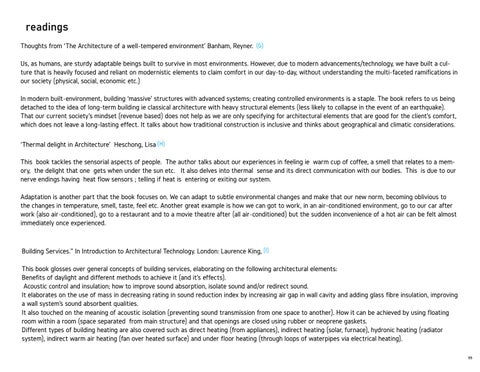readings Thoughts from ‘The Architecture of a well-tempered environment’ Banham, Reyner. (G) Us, as humans, are sturdy adaptable beings built to survive in most environments. However, due to modern advancements/technology, we have built a culture that is heavily focused and reliant on modernistic elements to claim comfort in our day-to-day, without understanding the multi-faceted ramifications in our society (physical, social, economic etc.) In modern built-environment, building ‘massive’ structures with advanced systems; creating controlled environments is a staple. The book refers to us being detached to the idea of long-term building ie classical architecture with heavy structural elements (less likely to collapse in the event of an earthquake). That our current society’s mindset (revenue based) does not help as we are only specifying for architectural elements that are good for the client’s comfort, which does not leave a long-lasting effect. It talks about how traditional construction is inclusive and thinks about geographical and climatic considerations. ‘Thermal delight in Architecture’ Heschong, Lisa (H) This book tackles the sensorial aspects of people. The author talks about our experiences in feeling ie warm cup of coffee, a smell that relates to a memory, the delight that one gets when under the sun etc. It also delves into thermal sense and its direct communication with our bodies. This is due to our nerve endings having heat flow sensors ; telling if heat is entering or exiting our system. Adaptation is another part that the book focuses on. We can adapt to subtle environmental changes and make that our new norm, becoming oblivious to the changes in temperature, smell, taste, feel etc. Another great example is how we can got to work, in an air-conditioned environment, go to our car after work (also air-conditioned), go to a restaurant and to a movie theatre after (all air-conditioned) but the sudden inconvenience of a hot air can be felt almost immediately once experienced.
Building Services.” In Introduction to Architectural Technology. London: Laurence King, (I) This book glosses over general concepts of building services, elaborating on the following architectural elements: Benefits of daylight and different methods to achieve it (and it’s effects). Acoustic control and insulation; how to improve sound absorption, isolate sound and/or redirect sound. It elaborates on the use of mass in decreasing rating in sound reduction index by increasing air gap in wall cavity and adding glass fibre insulation, improving a wall system’s sound absorbent qualities. It also touched on the meaning of acoustic isolation (preventing sound transmission from one space to another). How it can be achieved by using floating room within a room (space separated from main structure) and that openings are closed using rubber or neoprene gaskets. Different types of building heating are also covered such as direct heating (from appliances), indirect heating (solar, furnace), hydronic heating (radiator system), indirect warm air heating (fan over heated surface) and under floor heating (through loops of waterpipes via electrical heating). 55








